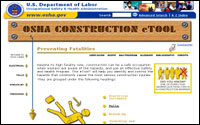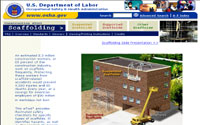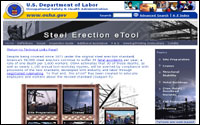 |
Fall Protection |
|
| Construction |
|
|
|
 |
Quick Link |
 |
 |
For
information related to general industry, see OSHA's
Fall Protection page. |
|
|
In 2006, the Bureau of Labor Statistics (BLS) reported
that 1,226 construction workers died on the job, with 35 percent of those
fatalities resulting from falls [More...]
Hot Topics
Alliances
- Construction.
OSHA's Alliance Program. This is one of OSHA's Strategic Management Plan Focus
Areas.
 eTools eTools
-
Construction. OSHA. A Spanish version is also available. Contains information that helps workers identify and control the hazards that cause the most serious construction-related injuries.
-
Falls. Provides possible solutions to unprotected openings, improper
scaffold construction, unguarded rebars, and misuse of portable ladders.
 Scaffolding. OSHA. Provides illustrated safety checklists for specific
types of scaffolds. Hazards are identified, as well as the controls that keep
these hazards from becoming tragedies. An estimated 2.3
million construction workers, or 65 percent of the construction industry, work
on scaffolds frequently. Scaffolding. OSHA. Provides illustrated safety checklists for specific
types of scaffolds. Hazards are identified, as well as the controls that keep
these hazards from becoming tragedies. An estimated 2.3
million construction workers, or 65 percent of the construction industry, work
on scaffolds frequently.
-
 Steel Erection. OSHA. Contains information that helps workers identify and control the hazards that cause the most serious steel erection-related injuries. Steel Erection. OSHA. Contains information that helps workers identify and control the hazards that cause the most serious steel erection-related injuries.
- Fall Protection.
Describes general fall protection requirements, and special requirements
for steel erection.
Standards
Fall protection is addressed in specific standards for the
construction industry. This section highlights OSHA standards, Federal Registers
(rules, proposed rules, and notices) preambles to final rules (background to
final rules), directives (instructions for compliance officers), standard
interpretations (official letters of interpretation of the standards), example
cases, and national consensus standards related to fall protection.
OSHA
Highlighted Standards
Construction Industry (29 CFR 1926)
- 1926 Subpart E,
Personal protective and life saving equipment
- 1926 Subpart L, Scaffolds [related topic page]
- 1926.451, General requirements
- 1926.452, Additional requirements applicable to specific types of scaffolds
- 1926.454, Training requirements
- Appendix B, Criteria for determining the feasibility of providing safe access and fall protection for scaffold erectors and dismantlers
- Appendix D, List of training topics for scaffold erectors and dismantlers
- 1926 Subpart M, Fall protection
- 1926.500, Scope, application, and definitions applicable to this subpart
- 1926.501, Duty to have fall protection
- 1926.502, Fall protection systems criteria and practices
- 1926.503, Training requirements
- Appendix A, Determining roof widths - Non-mandatory guidelines for complying with 1926.501(b)(10)
- Appendix B, Guardrail systems - Non-mandatory guidelines for complying with 1926.502(b)
- Appendix C, Personal fall arrest systems - Non-mandatory guidelines for complying with 1926.502(d)
- Appendix D, Positioning device systems - Non-mandatory guidelines for complying with 1926.502(e)
- Appendix E, Sample fall protection plan - Non-mandatory guidelines for complying with 1926.502(k)
- 1926 Subpart P,
Excavations [related topic page]
- 1926.651, Specific excavation requirements
- 1926 Subpart R, Steel erection [related topic page]
- 1926 Subpart S, Underground construction, caissons, cofferdams, and compressed air
- 1926 Subpart X, Ladders
- For additional information on specific state plans or other general
standards, see the general industry
Standards page.
Federal Registers
- Safety Standards for Steel Erection. Final Rules 66:5317-5325, (2001, January 18). Contains requirements for hoisting and rigging, structural steel assembly, beam and column connections, joist erection, systems-engineered metal building erection, fall protection, and training.
-
Employer Payment for Personal Protective Equipment. Notice 69:41221-41225, (2004, July 8). OSHA issued a proposed rule to require
employers to pay for personal protective equipment (PPE), (including fall
protection) used by their employees. The record was closed on December 13,
1999. OSHA has determined further public comment is needed regarding the types
of (PPE) that are typically supplied by the employee, taken from job site to job
site, and considered to be "tools of the trade."
- Safety Standards for Fall Protection in the Construction Industry.
Proposed Rules 64:38077-38086, (1999, July 14). OSHA addressed ten issues, most of which have been raised by interested parties who believe that alternatives to some of the existing fall protection rule's provisions should be permitted. They generally recommend that OSHA allow work practices rather than personal fall arrest systems and guardrails to protect employees against falls.
-
Search all available Federal Registers.
Regulatory Agenda
- The
OSHA
Regulatory Agenda
contains an entry related to walking/working surfaces and personal fall protection
systems.
Preambles to Final Rules
Directives
Communications Industry
Construction Industry
- Plain Language Revision of OSHA Instruction. STD 03-00-001 [STD 3-0.1A], (1999, June 18).
Provides a plain language re-write of OSHA instruction STD 3.1, the agency's interim enforcement policy on fall protection for certain residential construction activities.
- Inspection Procedures for Enforcing Subpart L, Scaffolds Used in Construction - 29 CFR 1926.450-454. CPL 02-01-023 [CPL 2-1.23], (1997, January 7).
- Change to the Construction Standard Alleged Violation Elements (SAVES) Manual. CPL 02-00-034 [CPL 2.34], (1992, August 3). Includes fall protection-related SAVES from 29 CFR 1926.800.
- Changes to the Construction Standard Alleged Violation Elements (SAVES) Manual. CPL 02-00-034 [CPL 2.34], (1991, July 15). Includes some SAVES for fall protection related to ladders.
- Change to the Construction Standard Alleged Violation Elements (SAVES) Manual. CPL 02-00-034 [CPL 2.34], (1990, August 6). Includes SAVES related to fall protection.
Steel Erection Industry
Standard Interpretations
- Whether OSHA standards prohibit using two power hoists wired together to a single control; whether a minimum of two persons are required to be on board a two-point suspended scaffold. (2006, January 25).
Indicates that the employer would be prohibited from
using this configuration unless each hoist and the central control were
all tested by a qualified laboratory after the motors were wired together.
1926 Subpart L does not specify a minimum number of employees
that must be on board for operation of a two-point suspension scaffold.
- Fall protection requirements for workers on guardrail-equipped platforms. (2005, November 29).
Determines that working from an elevated scissor
lift (ANSI A92.6 series), a worker need only be protected from falling by a
properly designed and maintained guardrail system. However, if the guardrail
system is less than adequate, or the worker leaves the safety of the work
platform, an additional fall protection device would be required.
- Use of a warning line instead of conventional fall protection; Part 1926 Subpart M. (2005, January 3).
Indicates that distance alone is ineffective to protect workers from
unprotected sides or edges. However, we have determined that, in the area
further back from the distances specified for the warning lines permitted
under the standard, there is a point that is sufficiently far from the edge or
hole to warrant the application of a de minimis policy regarding
non-conforming guardrails.
- Residential fall protection: safety monitors; walking top plate of braced walls in installation; warning line; plating exterior walls; height limitation; non-roofer PPE; slide guards. (2004, November 30).
Addresses multiple issues in fall protection for roofers.
- Fall protection requirements for employees working from a slide-out extension of a scissor lift platform. (2004, September 14).
Determines that the worker on the slide-out platform
must be protected by either a guardrail system or a personal fall arrest
system.
- Requirements for employees working over water <2 feet deep. (2004, August 23).
Determines that when continuous fall protection is used
(without exception) to prevent employees from falling into the water, the
employer has effectively removed the drowning hazard, and life jackets or
buoyant work vests are not needed.
- Use of fall protection by deaf employees performing steel erection activities. (2004, August 3).
Indicates that each employee engaged in a steel erection activity who is on a
walking/working surface with an unprotected side or edge more than 15 feet
(4.6 m) above a lower level shall be protected from fall hazards by
guardrail systems, safety net systems, personal fall arrest systems,
positioning device systems or fall restraint systems. None of these systems rely on verbal warnings or
cues.
-
The construction fall protection standard specifies fall arrest system requirements, but no footwear requirements. (2004, May 28). Determines
that there is no additional requirement in the
standard regarding any specific types of footwear that must be used.
- Construction of homes with masonry walls is not considered "residential construction" in applying STD 03-00-001. (2004, May 17).
Indicates that residential construction is not
determined by the structure's ultimate use (commercial vs. residential);
rather, residential construction is characterized by the working environment,
methods, materials, and procedures used.
- Evaluation of the Jax Scaffold System. (2004, April 21).
- Fall protection requirements for pump jack scaffold railings. (2004, March 25).
Indicates that according to the independent test results
supplied the strength requirements have been met.
- Permissibility of attaching welding leads to an occupied lift bucket and using an external lifeline to anchor fall arrest equipment. (2004, February 23).
Determines that limited situations may exist where an
adjacent structure poses no reasonably foreseeable risk of failure. However,
boom and basket load limits specified by the manufacturer shall not be
exceeded.
- Fall protection requirements for work docks/bridges used during bridge
construction. (2004, February 9). Concludes
that the use of work docks or work bridges built to help construct the bridge
or to load/unload construction materials and equipment onto barges must
therefore meet
1926 Subpart L.
- Clarification on several issues regarding OSHA's construction industry standards for fall protection. (2003, December 18).
-
Compliance of using warning lines and/or control access zones for fall protection on roofs with a slope greater than 4:12.
(2003, September 26).
-
Fall protection requirements during installation and removal of tarps and sheeting on/from scaffolds; qualifications of person determining safety on scaffold with wind imposed forces.
(2003, July 16). Determines that the installation and
removal of tarps or other sheeting material is not considered erection or
dismantling of a scaffold. The addition of a tarp or other sheeting material would add lateral
loads to the scaffold, and would be "an occurrence which
could affect a scaffold's structural integrity," requiring a competent person to
inspect it and make an assessment of the anticipated
wind forces imposed.
-
Requirements for fall protection when ladder jack scaffolds are used for residential and commercial construction.
(2003, July 7). Indicates that workers are prohibited
from being on a ladder jack platform over 20 feet high. This limitation
applies in both residential and non-residential construction.
-
Maintenance vs. construction; working from fixed ladders. (1999, May 11).
Discusses the differences between "maintenance" and "construction" and the
applicable standards.
- Search all available
standard interpretations.
Electric Power Industry
Example Cases
- OSHA Proposes $128,000 in Penalties Against DeSoto, Texas-based J&R Landmark Construction Corp. for Alleged Safety Violations in Houston.
Region 6 News Release, (2005, January 18). Proposes penalties for a DeSoto,
Texas-based
construction
company's
alleged
repeated
failures to
properly erect
scaffold
equipment and
follow safety
standards at a
Houston,
Texas,
construction
site.
- OSHA Cites Fitchburg, Mass. Steel Erector for Unsafe Conditions at Merrimack, New Hampshire, Site. Region
1 News Release, (2004, August 9). A Fitchburg, Mass., steel contractor's failure to follow proper procedures and ensure fall protection for its workers at a Merrimack, N.H., construction site has resulted in $194,700 in fines from OSHA.
- Continued Failure to Protect Roofers from Injury Leads to $141,000 Fine for Lawrenceville, Georgia Firm. Region
5 News Release, (2003, May 27). A Lawrenceville, Ga. company is facing $141,000 in fines proposed by OSHA following a January, 2003 inspection of a worksite where the company allowed roofers to work at serious safety risk.
- Numerous Scaffolding Hazards Bring Staten Island Company $292,500 In OSHA Fines Fall Protection Special Emphasis Program Prompts Inspections.
Region 2 News Release, (2002, September 17). Numerous and repeated employee
exposures to scaffolding hazards at two construction sites have resulted in OSHA citations and $292,500 in proposed fines against New York
Stucco, Inc., Staten Island, N.Y.
-
Fall Protection and Scaffolding Hazards at Long Island Work Sites Lead to $170,000 in Fines for Franklin Square, N.Y., Contractor.
Region 2 News Release, (2003, July 3). A Franklin Square, N.Y. stucco
contractor's failure to protect employees from the hazards of working on roofs
and elevated scaffolds at two Long Island work sites has resulted in citations
and substantial fines from OSHA.
National Consensus
Note: These are NOT OSHA regulations. However, they do
provide guidance from their originating organizations related to worker
protection.
American National Standards Institute (ANSI)/American
Society of Safety Engineers (ASSE)
- A10.32-2004, Fall Protection Systems for Construction and Demolitions Operations. Establishes performance criteria for personal fall protection equipment and systems in construction and demolition and provides guidelines, recommendations for their use and inspection.
American National Standards Institute (ANSI)
- Z359.1-1992 (R1999), Safety Requirements for
Personal Fall Arrest Systems, Subsystems and Components. Establishes
requirements for the performance, design, marking, qualification, instruction,
training, inspection, use, maintenance, and removal from service of connectors,
full body harnesses, lanyards, energy absorbers, anchorage connectors, fall
arresters, vertical lifelines, and self-retracting lanyards comprising personal
fall arrest systems for users within the capacity range of 130 to 310 pounds (59
to 140 kg).
Hazards and Possible Solutions
Occupational fatalities caused by falls remain a serious
public health problem. The US Department of Labor
(DOL) lists falls as one of the leading causes of traumatic occupational death,
accounting for eight percent of all occupational fatalities from trauma. Before
you can begin a fall protection program, all potential fall
hazards must be identified. The following references aid in
recognizing and evaluating hazards and possible solutions in the workplace.
-
Construction Resource Manual. OSHA, (1998).
-
Construction - Pocket Guide. OSHA Publication 3252-05N, (2005).
Also available as a 285 KB
PDF, 36 pages.
Reports that nearly 6.5 million people work at approximately
252,000 construction sites across the nation on any given day. The
fatal injury rate for the construction industry is higher than the
national average in this category for all industries.
-
What's the Fall Distance? OSHA Video, (1998), 22 minutes. Links to a
video that introduces the viewer to fall distance calculations for personal
fall arrest systems.
- Fall Protection in Construction. OSHA
Publication 3146, (1998). Also available as a 177 KB
PDF, 43 pages. Discusses general fall protection concepts and
1926 Subpart M.
-
Stairways and Ladders: A Guide to OSHA Rules.
OSHA Publication 3124-12R, (2003). Also available as a 278 KB
PDF, 15 pages. Includes fall protection topics for stairways and ladders.
-
Fall Protection: Safe practices for setting and
bracing wood trusses and rafters. Oregon OSHA, (2005), 386 KB
PDF, 19 pages. A 238 KB
PDF, (Spanish version) is also available.
- Fall Protection in the Construction Industry.
(2003, October), 662 KB
PDF, 82 pages. Explains general concepts and best practices.
-
Fall Protection Publications. Includes fall protection
publications for the construction industry, for setting and bracing wood
trusses and rafters, for setting floor joists, sheathing/decking, and
constructing exterior walls, options for specialty contractors, temporary
elevated work platforms, and walking working surfaces.
- Drilled Shaft Installation Safety.
International Association of Foundation Drilling (ADSC)/OSHA Alliance, 4 MB
PDF, 52 pages. Identifies potential fall hazards at the
surface of the shaft, the use of personal protective equipment and guardrail
systems as methods of fall protection, as well as recommended procedures for
safe drilled shaft installation.
-
Making
a Positive Difference: OSHA Saves Lives. OSHA.
Discusses case examples of how OSHA standards have saved lives.
-
Compatibility of Personal Fall Protection System Components.
OSHA Safety and Health Information Bulletin (SHIB), (2003, September 22).
Also available as a 60 KB
PDF, 4 pages.
-
Increase in Falls Spurs OSHA to Remind Southwestern Connecticut Employers to Review Fall Protection Safeguards. OSHA Region
1 News Release, (2003, April 7). Disturbed by a recent round of worker falls and by numerous fall protection violations found during its inspections in southwestern Connecticut, OSHA's Bridgeport office called upon employers to take effective steps to protect their workers against the number one killer in construction. The agency held a free fall protection Compliance assistance seminar for area employers at the Bridgeport Public Library.
-
Fall Protection-It's a Snap! OSHA, (2003, February 3).
Provides an "Employer Information Kit" developed for use by construction employers or trainers to voluntarily comply with OSHA's fall protection standards.
-
The 100 Most Frequently Cited OSHA Construction Standards in 1991: A Guide for the Abatement of the Top 25 Associated Physical Hazards.
OSHA, (1995, March). Also available as a 2 MB
PDF, 100 pages. Discusses the most-violated OSHA construction standards. Several of these standards have to do with falls and fall protection.
-
Preventing
Injuries and Deaths from Falls During Construction and Maintenance
of Telecommunication Towers. US Department of Health and Human
Services (DHHS), National Institute for Occupational Safety and
Health (NIOSH) Publication No. 2001-156,
(2001, July). Discusses how workers who are involved in construction and maintenance of telecommunications towers are
at high risk of fatal falls.
- NIOSH
Issues Nationwide Alert on Dangers of Working from Scaffolds.
US Department of Health and Human Services (DHHS), National
Institute for Occupational Safety and Health (NIOSH) Publication
No. 93-120, (1993, January 4). Discusses the dangers of working from scaffolds.
- Preventing Worker Injuries and Deaths Caused by Falls from Suspension Scaffolds.
US Department of Health and Human Services (DHHS), National Institute for Occupational Safety and Health (NIOSH) Publication No. 92-108, (1992, August). Describes five incidents resulting in six deaths caused by falls from suspension scaffolds.
-
Preventing Worker Deaths and Injuries from Falls Through Skylights and Roof Openings.
US Department of Health and Human Services (DHHS), National
Institute for Occupational Safety and Health (NIOSH) Publication No. 90-100, (1989, December).
Describes eight deaths resulting from falls that occurred during
work around these openings.
Additional Information
Related Safety and Health Topics Pages
Training
Other Resources
|
|
|
|

